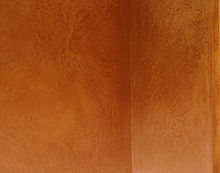Tadelakt: Difference between revisions
m deletion of repetition |
Asgardiator (talk | contribs) added noref, rewrite. |
||
| Line 1: | Line 1: | ||
{{noref}} |
|||
{{rewrite}} |
|||
The craft of “tadelakt” is a Moroccan tradition, using lime from The Marrakech Plateau, where the original tadelakt lime can be found. That's where the word "tadelakt" comes from, it means "to rub in", where olive soap is rubbed in resulting in a hydrophobic lime plaster used on both the interior and exteriors of buildings. It is the traditional coating of the palaces, hammams and bathrooms of the [[riad (Morocco)|riad]]s in [[Morocco]]. Traditional application includes polishing with river stone and treatment with [[oleic acid]] in the form of olive oil soap to acquire its final appearance and water resistance. Tadelakt has a luxurious, soft, undulating character, and has been employed for baths, showers, and basins. |
The craft of “tadelakt” is a Moroccan tradition, using lime from The Marrakech Plateau, where the original tadelakt lime can be found. That's where the word "tadelakt" comes from, it means "to rub in", where olive soap is rubbed in resulting in a hydrophobic lime plaster used on both the interior and exteriors of buildings. It is the traditional coating of the palaces, hammams and bathrooms of the [[riad (Morocco)|riad]]s in [[Morocco]]. Traditional application includes polishing with river stone and treatment with [[oleic acid]] in the form of olive oil soap to acquire its final appearance and water resistance. Tadelakt has a luxurious, soft, undulating character, and has been employed for baths, showers, and basins. |
||
[[Image:Echantillon Tadelakt-Stéphane Baron.jpg|thumb|A Tadelakt covered wall]] |
[[Image:Echantillon Tadelakt-Stéphane Baron.jpg|thumb|A Tadelakt covered wall]] |
||
Revision as of 22:31, 15 October 2015
This article may need to be rewritten to comply with Wikipedia's quality standards. |
The craft of “tadelakt” is a Moroccan tradition, using lime from The Marrakech Plateau, where the original tadelakt lime can be found. That's where the word "tadelakt" comes from, it means "to rub in", where olive soap is rubbed in resulting in a hydrophobic lime plaster used on both the interior and exteriors of buildings. It is the traditional coating of the palaces, hammams and bathrooms of the riads in Morocco. Traditional application includes polishing with river stone and treatment with oleic acid in the form of olive oil soap to acquire its final appearance and water resistance. Tadelakt has a luxurious, soft, undulating character, and has been employed for baths, showers, and basins.

This plaster finish was used during the restoration of the riads of Morocco.
Constituents
The basic constituents of tadelakt plaster are:
- lime plaster (not Portland cement)
- possible inclusion of marble or limestone sand (but not other aggregates)
- compressed when plastic to eliminate voids
- mechanically polished using stones or abrasives harder than the plaster, providing a smooth, sometimes shiny, finish.
- treated with natural soap (often "black" or olive oil soap) to speed carbonation of the surface and impart water-resistance.
Techniques

In Morocco, the traditional application technique:
- plaster powder is mixed with water for 12 to 15 hours prior to the addition of pigment.
- the plaster is applied in one thick coat with a wooden float, and smoothed with the same.
- a flat, smooth, hard stone is used to compress the plaster, then a plastic trowel used for the final polish.
- last, sealed with an olive oil soap solution
